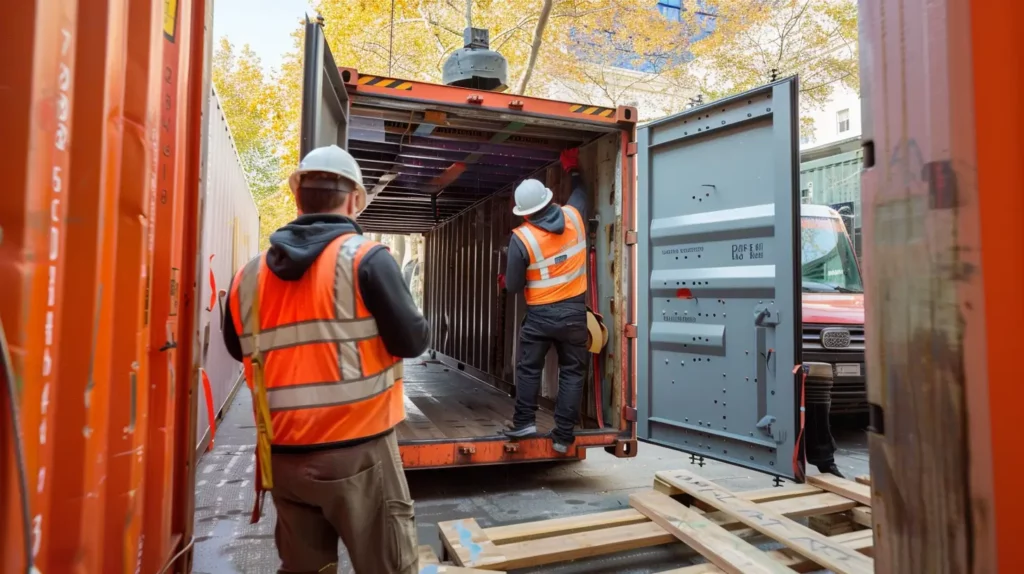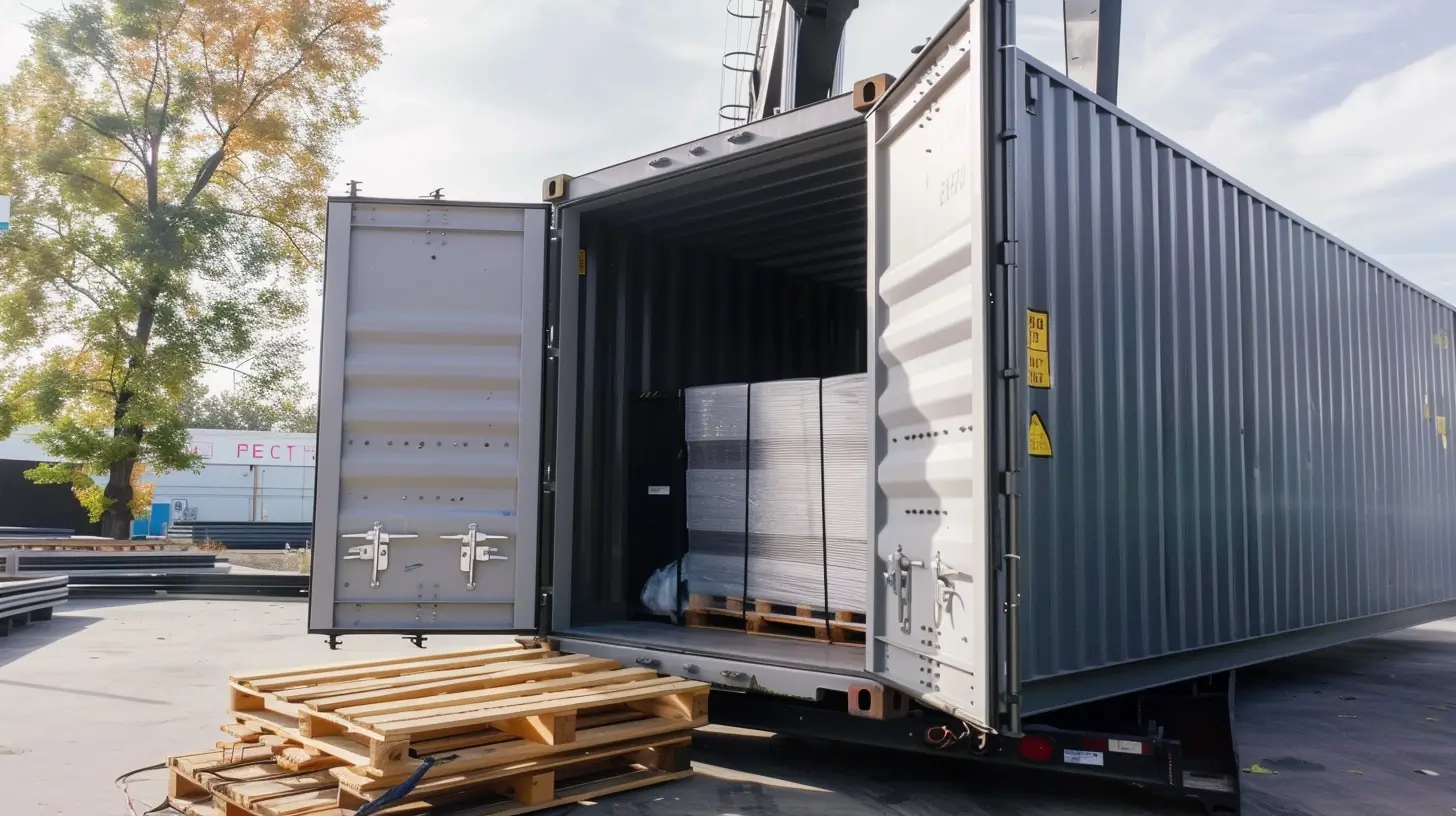Just like packing and unpacking for a holiday, unloading a shipping container is often much easier than loading one, especially if you are well-prepared. No matter what you’re using a shipping container for, whether it’s storage or transporting goods, you’ll need a process in place for how you’re going to unload it quickly and effectively.
When loading a shipping container, you need to consider lots of factors, including packing your items so they don’t get damaged in transit. With unloading, your goods have already arrived, so things tend to move a little quicker. But it’s not all about the goods, unloading the shipping container itself can be a complex operation. It’s important to know how the process of unloading your container works in order to do it safely, prevent damage, and keep everything running smoothly.
How long does it take to unload a shipping container?
The time it takes you to unload a shipping container varies depending on a few factors. These include the container size, the goods inside, the amount of people-power you have, and of course, how quickly you can move.
As a rough guide, it can take anywhere from one to four hours to unload a shipping container. It usually takes between one and one and a half hours to unload a 20-foot container, and around one and a half to two and a half hours for a 40-foot unit.
If you’re unloading a container filled with large or bulky items, it may take you longer to empty it, especially if manual handling is required. While there are likely to be fewer items inside if they are larger, it can still take a chunk of time if there aren’t enough hands on deck to support the heavy lifting.
Containers with small items may be quicker to unload if they are on pallets or in boxes. However, if these small items are loose or loaded in an unorganised manner, it may take even longer if you have to filter through everything as you take it out.
While you’ll inevitably want to unload a shipping container as quickly as possible, it’s important to ensure you’re unloading it safely. You should also keep in mind that if you are unloading goods at a dock, you may incur extra charges if you spend longer than your allocated time.
Want to avoid hassle during unloading?
Check out our large selection of new and used shipping containers and find the perfect match for your needs!
Learn morePreparing for unloading the shipping container
Before you start unloading a shipping container, you need to properly prepare the site where it will be placed. The unloading area must be well-equipped to safely handle incoming containers and all the required equipment, whether you’re at a dock, your home, or another location.
It’s important to make sure there is enough room for forklifts, pallet jacks, and other machinery so they can move around safely without obstruction. Another consideration is lighting and ensuring there is adequate light for spotting hazards like broken glass, sharp objects, or leaks from the unit.
Before your shipping container can be placed on the ground, you also need to make sure the ground is level and free from any obstruction. If your container is being delivered to its permanent home, you will need to ensure appropriate foundations have been laid.
Not sure which foundation to use for your container?
Different foundations suit different setups, from quick temporary installs to heavy-duty permanent bases. Understanding what each one offers helps you choose with confidence.
Learn all about the most common foundation solutions and what to consider before you start in our detailed guide.
Read guideEquipment needed to unload a shipping container
To make unloading a shipping container smooth and efficient, you’ll need a few essential tools and equipment. The right vehicles and gear can help make the process faster and easier.
Depending on what’s inside the shipping container, you can make sure the right tools are ready and waiting on site. For example, if your goods are loaded onto pallets, a forklift with a container-loading mast and a strong container-loading ramp will be useful.
Crane
Before you start unloading your shipping container, you’ll need a crane to secure it. When choosing the best crane for the job, you should consider the dimensions and weight of the container you’re going to be unloading. You’ll also want to think about the space and location where the crane will be in operation.
No matter which type of crane you use, it’ll need to meet certain safety standards and be operated by experienced operators. It’s a good idea to provide your chosen crane hire company with as much information as possible about the unloading site and container so they can deliver the best crane for the job.
Ship-to-shore cranes
Ship-to-shore cranes (SPTS) cranes are often found at docks and terminals. They are essential fixtures designed to load and unload shipping containers from docked ships. STS cranes replace traditional hooks with specialist attachments known as ‘spreaders’, and are typically used to handle ISO standard containers and heavy units.
Gantry crane
Gantry cranes also handle cargo in ports and container terminals. These large cranes are designed to efficiently load and unload container ships and transfer containers onto their next transportation method. Equipped with hydraulic and electrical systems, gantry cranes can stack containers up to seven high, maximising any available storage space. Despite their large size, gantry cranes are used to handle all sizes of shipping containers.
Delivery truck
In some cases, you may need to relocate your container to a site away from the docks, which means you will need a delivery truck to get it from the docks to its new location.
Truck with crane
Shipping container delivery can be complex, but not if you have a truck with a crane on hand to help you. A truck with a crane can efficiently load or unload shipping containers from trucks, making it easier to get your container to its new home. Trucks with hi-ab cranes offer plenty of power and can reach up to 16 metres from the truck. This makes them the perfect solution for moving a container to a remote or confined space.
Tilt-bed truck
Tilt-bed trucks feature a hydraulic system that enables the truck bed to tilt and slide the container off the back and onto the ground. This method means additional cranes or forklifts are not required. In most cases, the shipping container is gently lowered to the ground, making delivery safe and more controlled when heavy machinery is not available. If you’re taking your container to a remote space or you do not have access to a crane, a tilt-bed truck offers the perfect solution.
Bolt cutters
It’s not all about the big bits of kit when it comes to unloading a shipping container. A strong pair of bolt cutters is essential too. Shipping containers are sealed with heavy-duty bolt seals at origin for safety, so when your container arrives, you’ll need to use your bolt cutters to cut the container seal and unlock the container doors.
Ladder/step ladder
Once your container is delivered, you may need a ladder or step ladder to easily access the unit, especially if it’s raised off the ground. For loose-loaded containers, you’ll need to climb in to begin unloading, a process known as ‘handballing’.
Forklift
If your shipping container items have been packed onto pallets, a forklift can be used to safely and efficiently unload them. However, you can’t just hire a forklift, you need to employ an experienced forklift driver with the right paperwork for unloading goods safely.
Reach stacker
If you’re unloading at a port where there may be hundreds of other containers, a reach stacker offers a versatile way to handle intermodal cargo containers in small terminals or medium-sized ports. These vehicles feature a telescoping boom, which means they can transport containers quickly and stack them in various rows.
Compared to forklifts and smaller pieces of equipment, reach stackers provide higher stacking and storage capacity up to a height of three or four containers.
Caster wheels
Remote or hard-to-reach locations can be difficult if truck access is restricted. In these cases, installing caster wheels can be a great solution. Shipping container caster wheels are also useful if you frequently need to reposition or move your container once it’s been unloaded the first time. Caster wheels are easily installed on the bottom of shipping containers, allowing the units to be moved and rotated up to 360 degrees with minimal effort.
Looking for a shipping container?
Check out our large selection of new and used shipping containers and find the perfect match for your needs!
Buy a shipping containerSafety measures for container unloading
Safety is one of the most important factors when it comes to unloading shipping containers. Whether you’re unloading a container at a port with business goods or you’re receiving your shipping container at another destination with personal items, safety is a critical consideration. Following a few simple steps will minimise the risk of injury or damage to your goods.
As a start, workers should wear appropriate Personal Protective Equipment (PPE), such as gloves, steel-toed boots, high-visibility vests and hard hats when unloading shipping containers. You should also never unload containers alone. There should be a dedicated team of professionals to maintain safe and efficient unloading. If machinery will be used during the unloading process, anyone operating it should be qualified, experienced, and insured to do so.
Chemical safety
When it comes to transporting and unloading chemical goods, there are a number of additional safety measures to think about. Whether you’re using a regular shipping container or a specialised COSHH chemical store container, you must adhere to safe working practices.
The following safe working practices under chemical safety guidelines should be followed for the safe unloading of chemical goods and minimising any potential risks to workers.
Personal protective equipment (PPE)
While PPE is important for unloading any type of goods from a shipping container, it goes a little further for chemical goods. Workers must wear appropriate and functioning PPE based on the type of chemical being unloaded. This may include chemical-resistant gloves, face shields, respirators, and full-body protective suits. The use of proper PPE significantly reduces the risk of direct exposure to hazardous substances.
Chemical spill kits
Spill kits should always be on hand to contain leaks or spills during unloading. These kits typically include absorbent pads, neutralising agents, and containment booms. Having spill kits available can help to quickly manage any chemical leaks, preventing contamination and injuries.
Ventilation and air quality monitors
Chemical fumes can build up inside a container, which can be dangerous to those unloading goods. Air quality monitors should be used to detect dangerous gas levels, while ventilation systems should be in place to clear the area of any harmful vapours. This helps reduce the risk of inhalation and maintain a safe environment.
Explosion-proof equipment
If flammable or reactive chemicals are being unloaded, explosion-proof tools and machinery should be used. This includes forklifts, lighting, and electrical equipment designed to prevent sparks. Standard equipment is not advised as it can pose a fire risk in some chemical environments.
Material Safety Data Sheets (MSDS)
It is important to always keep Material Safety Data Sheets for each chemical available. These sheets provide detailed information on handling, storage, and emergency measures, which all workers should be familiar with before unloading starts.
Secondary containment
To prevent leaks or spills from spreading beyond the designated unloading area, secondary containment areas should be set up around the unloading zone. You can also use chemical-resistant mats or dikes to control any overflow.
Emergency showers and eyewash stations
In case of accidental exposure, emergency showers and eyewash stations should be easily accessible. Before unloading begins, it’s critical that workers know the location and how to use these stations for immediate decontamination.
Container unloading process

With your site prepared, the correct equipment ready, and safety measures in place, you can start unloading the shipping container. This involves several steps, from securing the container and inspecting for hazards to systematically unloading your goods.
Secure the rigger
A rigger is used to lift, secure, and oversee the overall operation between a crane operator and a truck driver. When arranging to unload a shipping container, including placing the container separately, you need to secure both the crane you’ll use to set it down and the rigger. You should also understand how the rigger will get to the container during unloading, so they can lift it. Riggers often have their own work safety guidelines that must be adhered to.
Secure the container
Once your rigger is secured, you need to secure the shipping container. This step is highly important, requiring careful work to avoid damage to the unit, the goods inside, or any property at the unloading site. If you’re unloading at a port or off a truck, the rigger will lift the unit with a crane, while the crane operator will carefully lift the container from the truck to its designated location. Safety instructions must be followed throughout this process, ensuring the container is placed correctly and precisely.
You should check that the shipping container is level and has been placed stably once it’s off the truck. You’ll want to ensure all four corners of the container are firmly on the foundation and cannot slide or move.
Inspect for hazards
Before you open the container doors or enter the shipping container, make sure the area is free from hazards. A key piece of advice when you start unloading – never stand directly in front of the doors.
Once you’ve checked the area for hazards or obstructions, open the container doors and allow some time for fresh air to circulate inside. This will improve ventilation for when you start unloading.
With the doors open and fresh air inside, you need to inspect the inside of the container. Look for any unstable items or shifts that may have happened during transportation.
Systemically unload the container
Before you start moving items out of the container, you need to make sure there is plenty of secure space for the unloaded goods. If you have a list of items inside the container, it’s a good idea to check them off as they are unloaded. This ensures everything is accounted for.
For mixed loads, we recommend separating heavy items first. This will help to avoid any shifting of the container that could damage lighter goods. However, be careful not to just pull out large items first if small items are placed on top. If your items are loaded onto crates or pallets, you can use a forklift for more efficient unloading.
Container unloading challenges and how to mitigate them
Of course, unloading a shipping container isn’t without its challenges, but there are ways to avoid them with careful planning and preparation.
Shifts and spills
Whether being transported by land or sea, cargo shifts and spills can be a major safety risk during the unloading process. When items are not properly secure before their journey, they can move unexpectedly, resulting in damage or safety issues.
To prevent this from happening, you should always properly secure your shipping container and its goods. Container lashing, with safety straps, rope, clamps etc. should be used on all loose or heavy items.
Downtime and labour costs
In most cases, you’re unlikely to be managing the entire shipping and unloading process yourself, which means you’ll have hired help. With this comes downtime and high labour costs – common challenges when unloading shipping containers. However, you can manage these challenges with proper planning.
You must assign workers based on the type and quantity of goods being unloaded, while also ensuring they have the right experience. This reduces the risk of overstaffing and long waiting periods at port.
Truck waiting time
Trucks waiting around for you to unload is a common issue that can raise costs and disrupt busy schedules. When containers are not unloaded and returned on time, as per your paperwork, detention fees can add up quickly. To minimise truck idle time and unexpected fees, you need to make sure you enforce accurate timing. It’s always best to err on the side of caution just in case.
What to do after unloading and emptying your container
With an empty container and goods unloaded, you must complete a few final safety and inventory checks. First, inspect the unloading area for any items left behind or damage to the shipping container. Next, ensure the container floors are clean and free from any debris. Finally, embark on a thorough stock count to make sure you have received all the goods that should have been in the unit. This will be much quicker if you checked items off your list as you unloaded them, but it’s still good to do a double-check.
The bottom line
Unloading a shipping container is not always an easy task, whether you’re using it for transportation or storage. But you can make it a more efficient task by following our simple steps for unloading and ensuring you adhere to important safety guidance.
If you’re at the beginning of your shipping container journey and need more information on container sizes, best practices, or modifications, contact our friendly team for advice.





